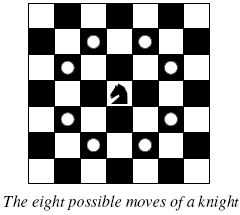POJ 2488 A Knight's Journey
Posted kindleheart
tags:
篇首语:本文由小常识网(cha138.com)小编为大家整理,主要介绍了POJ 2488 A Knight's Journey相关的知识,希望对你有一定的参考价值。

Background
The knight is getting bored of seeing the same black and white squares again and again and has decided to make a journey
around the world. Whenever a knight moves, it is two squares in one direction and one square perpendicular to this. The world of a knight is the chessboard he is living on. Our knight lives on a chessboard that has a smaller area than a regular 8 * 8 board, but it is still rectangular. Can you help this adventurous knight to make travel plans?
Problem
Find a path such that the knight visits every square once. The knight can start and end on any square of the board.
The knight is getting bored of seeing the same black and white squares again and again and has decided to make a journey
around the world. Whenever a knight moves, it is two squares in one direction and one square perpendicular to this. The world of a knight is the chessboard he is living on. Our knight lives on a chessboard that has a smaller area than a regular 8 * 8 board, but it is still rectangular. Can you help this adventurous knight to make travel plans?
Problem
Find a path such that the knight visits every square once. The knight can start and end on any square of the board.
Input
The input begins with a positive integer n in the first line. The following lines contain n test cases. Each test case consists of a single line with two positive integers p and q, such that 1 <= p * q <= 26. This represents a p * q chessboard, where p describes how many different square numbers 1, . . . , p exist, q describes how many different square letters exist. These are the first q letters of the Latin alphabet: A, . . .
Output
The output for every scenario begins with a line containing "Scenario #i:", where i is the number of the scenario starting at 1. Then print a single line containing the lexicographically first path that visits all squares of the chessboard with knight moves followed by an empty line. The path should be given on a single line by concatenating the names of the visited squares. Each square name consists of a capital letter followed by a number.
If no such path exist, you should output impossible on a single line.
If no such path exist, you should output impossible on a single line.
Sample Input
3 1 1 2 3 4 3
Sample Output
Scenario #1: A1 Scenario #2: impossible Scenario #3: A1B3C1A2B4C2A3B1C3A4B2C4
题目大意:bfs求最短路问题,在棋盘上骑士要走遍棋盘上所有的位置,如果可以走完输出按字典序!!!排序的路径,否则输出impossible,这里特别注意国际象棋中骑士是按日字跳跃的,所以有8个方向可以行走,这里要输出按字典序排序的路径,那么可以直接找出所有可以到达的路径再进行排序,但是这样会超时,因为当棋盘很大的时候,走法很多。那么其实有个更巧妙的办法,那就是开始的时候把跳跃的8个方向的顺序按字典序排序,那么第一次成功时的路径就是字典序最小的路径。
int dx[] = {-1, 1, -2, 2, -2, 2, -1, 1};//按字典顺序定义好行走方向
int dy[] = {-2, -2, -1, -1, 1, 1, 2, 2};
代码:
#include<iostream> #include<cstdio> #include<queue> using namespace std; const int N = 30; typedef struct { int x; int y; } P; P que[1000]; int cur = 0; int n, m; int vis[N][N]; int dx[] = {-1, 1, -2, 2, -2, 2, -1, 1};//按字典顺序定义好行走方向 int dy[] = {-2, -2, -1, -1, 1, 1, 2, 2}; int dfs(int x, int y, int num) { int flag = 0; if(num == n*m) { printf("A1"); for(int i = 0; i < cur; i++) { printf("%c%d", ‘A‘+que[i].y, que[i].x + 1); } printf(" "); return 1; } for(int i = 0; i < 8; i++) { int nx = x + dx[i], ny = y + dy[i]; if(nx >= 0 && nx < n && ny >= 0 && ny < m && !vis[nx][ny]) { vis[nx][ny] = 1; que[cur].x = nx; que[cur].y = ny; cur++; flag = dfs(nx, ny, num+1); vis[nx][ny] = 0; cur--; if(flag) return flag; } } return flag; } int main() { int t; scanf("%d", &t); for(int i = 1; i <= t; i++) { scanf("%d%d", &n, &m); vis[0][0] = 1; printf("Scenario #%d: ", i); if(!dfs(0, 0, 1)) { printf("impossible "); } } return 0; }
以上是关于POJ 2488 A Knight's Journey的主要内容,如果未能解决你的问题,请参考以下文章
POJ 2488-A Knight's Journey(DFS)
poj-2488 a knight's journey(搜索题)